My Camp Kitchen and Those Fuel Canisters
Outdoor Element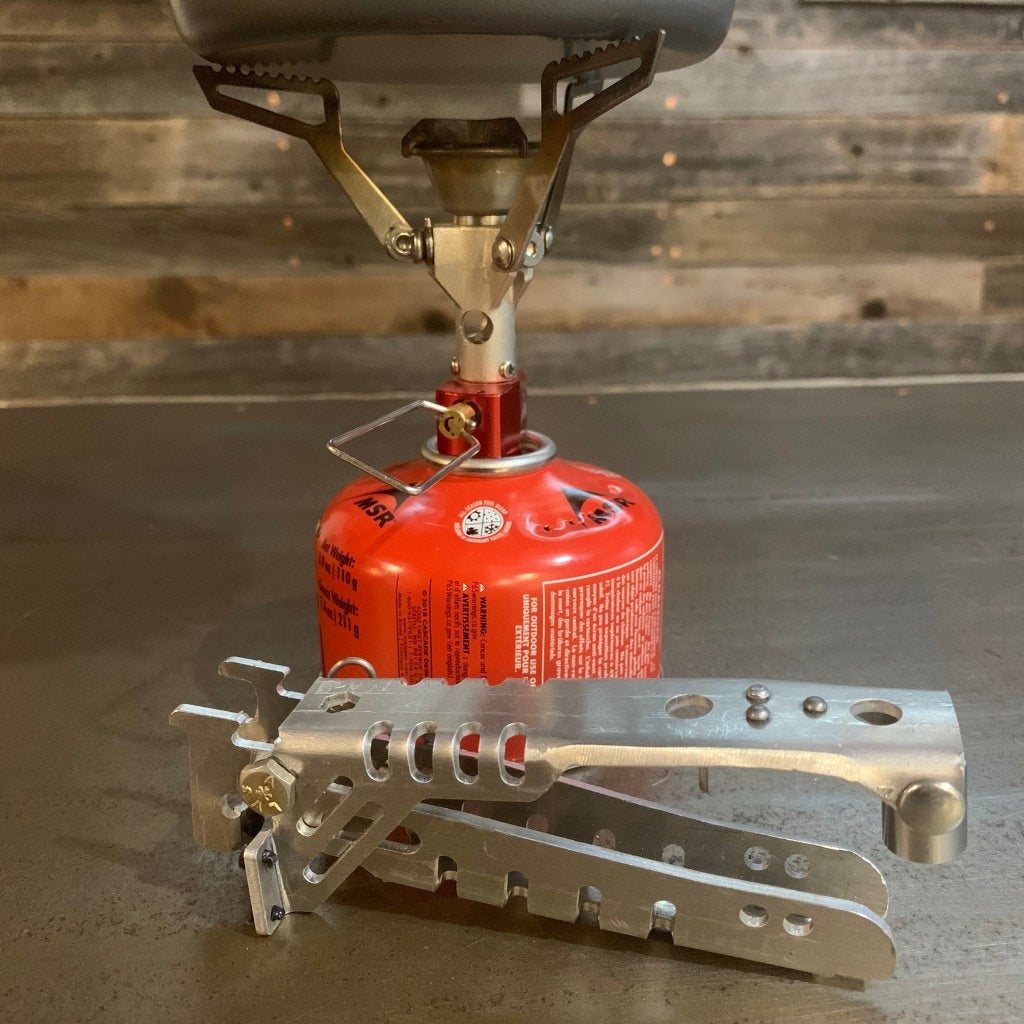
My camp kitchen typically involves an MSR Pocket Rocket, a fuel canister, and a pot for boiling water- for my Mountain House, freeze-dried meals. Biscuits and gravy tend to be my flavor of choice. Have you ever experienced a mishap with your camp kitchen? Perhaps you can relate to my story.
A couple of years ago, I was in the great outdoors with my daughter Cameron. It came time for a meal, and she started to boil some water.

We didn’t notice the pot wasn’t perfectly centered on the stove and the flame was creeping up the side of the pot and kissing the handle. When she grabbed it, she burned her hand. I felt horrible, there went my Dad of Year Award! After feeling sorry her and myself, I thought, oh she’s a young camper, she will figure it out. Then a few months later it happened to me! I thought there’s got to be room for design improvement (the engineer in me started to come out).

I quickly discovered MSR, GSI, and Primus make some decent pot gripper options. They are external handles to be used with camping pots. Because they’re not permanently attached, they don’t get hot, so you don’t get burned.
My next issue was with my fuel canister. Don’t get me wrong, I love these things; they’re easy to use, pretty lightweight, and portable. However, I initially had a few questions with these canisters. How do I know when they are approaching empty? What do I do with them when they are empty? Can I just toss these things in the trash? Are they still considered hazardous when the gas is depleted? I wondered if other people had similar questions. The curiosity was getting to me so created and sent out a survey.
I had over 1000 respondents to the survey (these were people already engaged in the outdoor space.) I asked several questions about fuel canisters, and a few of the questions confirmed there is an educational problem within our outdoor community. Are these canisters hazardous once they are empty? The answer is, yes. They are still pressurized and need to be dealt with appropriately. Imagine a pressurized can out on a hot summer day in the landfill…it can make for a small explosion. The survey suggested that almost half of the outdoor community was not really were unsure if they were hazardous.

About 68% of the people surveyed indicated they would like information to determine how full or empty these canisters are. I was always that guy with a second canister in his pack just in case my partial canister ran out of fuel during mid boil. Knowing how full a canister is can certainly save some hassles.

Then the big glaring response was to the question: do you know how to prepare them for disposal or recycle? About 66% of outdoor enthusiasts did not know what to do with these depleted canisters.

I felt there was room for both education and innovation …hence my experiment and this writeup.
The Fuel Canister Experiment
First, I wanted to know when to expect my fuel canister to be empty. In reality, I wanted to know how many boils I could get out of it. Let’s get back to my Mountain House meals. These are a staple for me and my family. On average, each packet takes about 2 cups of boiling water to reconstitute. I set up my experiment with this “meal plan” in mind. I started with a brand new small 4-ounce MSR IsoPro all-season fuel blend canister. They have an excellent 80/20 mix of isobutane and propane. It burns clean and I have never had any issues with it at altitude (anywhere from 5,000 to 10,000 feet above sea level) or in cold weather.

I tried to keep my experiment simple and controlled. I used a measuring cup for an exact 2 cups of water for each boil. My home is near Denver, around 5,000 feet of elevation. Water boils around 203 °F (95°C). Once I had a rolling boil, I let it boil for another 5-10 seconds. At higher altitudes It’s recommended that you let your water boil a little longer the Center for Disease Control and Prevention recommends that water should be brought to a rolling boil for 1 minute to kill all pathogens. At altitudes greater than 2000 m/6,562 ft, you should boil water for 3 minutes. This was done indoors with no cross wind and without Giardia or Cryptosporidium in mind. …I was just thinking about my Biscuits and Gravy. For reference, below is a table for boiling water at different altitudes. The takeaway is: at higher altitudes it boils faster, at a lower temperature…so let it boil longer if you’re worried about a contaminated water source.
| Altitude, ft (m) | Boiling point of water, °F (°C) |
| 0 (0 m) | 212°F (100°C) |
| 500 (150 m) | 211.1°F (99.5°C) |
| 1,000 (305 m) | 210.2°F (99°C) |
| 2,000 (610 m) | 208.4°F (98°C) |
| 5,000 (1524 m) | 203°F (95°C) |
| 6,000 (1829 m) | 201.1°F (94°C) |
| 8,000 (2438 m) | 197.4°F (91.9°C) |
| 10,000 (3048 m) | 193.6°F (89.8°C) |
| 12,000 (3658 m) | 189.8°F (87.6°C) |
| 14,000 (4267 m) | 185.9°F (85.5°C) |
| 15,000 (4572 m) | 184.1°F (84.5°C) |
If your water source is mountain lake/river or a snow-capped mountain, just ask yourself, does a bear poop in the woods? Does a mountain goat poop on a mountain top? If you answer yes to either of these, then boil it longer.
Back to the experiment. I poured 2 cups in a 4-ounce (weight) aluminum pot. After each boil, I emptied the boiling water, cooled off the pot, refilled the pot, lit the MSR pocket Rocket stove, and placed the pot directly back on the center of the stove. …rinse and repeat. Every time the water reached a boiling point, I placed a tally mark on the canister to keep track of the “boil count.”

During the experiment, I also weighed the fuel canister and placed it in water a few times. The MSR fuel canisters (4 and 8 oz) conveniently have calibrated lines on the canister walls that indicate fuel level. When you place it in water, the float level will correspond to the amount of fuel left in the canister During my experiment, I discovered MSR’s markings were pretty accurate.
I video-documented the experiment and uploaded it to YouTube. Feel free to give it a watch and let me know if I should tweak the experiment (assuming I repeat the experiment). If I do it again, I will use a different brand of fuel and see how it preforms.
I looked up a few different canisters including: Primus, Snowpeak, MSR, Coleman, and Optimus. It appears that MSR is the only one that currently and conveniently places fuel gauge markings on the label (for both the 4- and 8-ounce canisters). Again, these marking are used to determine fuel level. …and I have grown to like them.


Results:
16! Yup, I was able to boil 2 cups of water at 5000 foot elevation 16 times! The average time to boil was about 2:35.
After I went through the experiment, I’ve concluded that other fuel canister companies should start adding fuel level markings to the side of their cans. It’s easy enough to find a small body of water and see how it floats. I recommend adding tally marks and tossing it in water each time you complete a boil. This way if you’re at higher altitudes and need a 3-minute rolling boil you will see what your “halfway” point is.
If you have any questions or comments, feel free to drop a line and I will do my best to respond.
What to do when the fuel canister is empty?!
Back to that empty canister. Okay, we have discussed that once it’s empty, it is still hazardous because it’s a pressurized container. You will need to depress the center Lindal valve and expend any remaining gas. Ideally, it is better to burn off the gas rather than let the butane/propane particles fly into the air. Make sure you do this in a well-ventilated area. Once the canister is empty, you will need to puncture holes in the wall of the canister. I have met people who just stab it with a knife. Personally, I prefer not to stab round metal objects with a knife. There are specility tools that are safer to use. JetBoil has a recycle tool, “CrunchIt” that will help in this endeavor.
As I mentioned, there’s an engineer in me. I created a tool that acts as both a pot gripper and a recycle tool. I use it at the end of the experiment. It has 3 basic functions:
- It acts as a pot gripper, so you don’t burn your hands.
- It has a nut that depresses the Lindal valve to remove any left-over gas.
- Once the all the gas is expelled, it has a nice lever arm for puncturing the canister walls.

Having the recycle tool connected to my pot gripper not only reduces the number of tools I need, but it acts as a reminder and educational piece. Every time I see the back end of my pot-gripper, I think “ah, yes, I need to deal with that canister once it’s used up; and I have the means to do it.” I call it “Handled” ….’cause you got your camp kitchen handled 😊. Check out the end of the video to see it in action. I also have a short 2-minute video of it here. Please recycle where possible. On that note, you do need to drop it off at a place that accepts “mixed metals.” Not every recycle center is created equal. At the very least, you now know how to dispose of the fuel canisters properly now. I hope this experiment provided you some useful information. I know it opened my eyes to things I can do better. Get on the trails and explore with confidence.
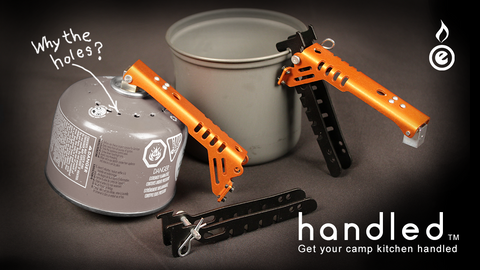

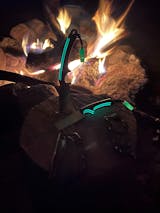
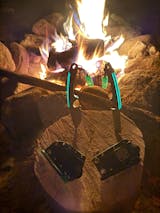
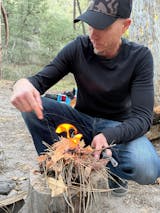
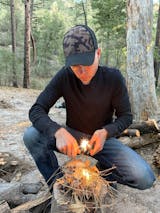
1 comment
I loved this article. I just completed the Overland track in Tasmania and learned a few things about my jet boil I had never encountered.
Firstly, I had only hiked at sea level in summer. This trip was at 1000m in very cold weather. My gas usage was far greater than previous experience. I always weigh my half empty canisters on kitchen scales after a trip, to get an idea of what I have left, so I was surprised to rip through gas so quickly.
I had one near disaster. I lit my burner in the dark with head torch, being quiet to avoid people in hut who were not out of their sleeping bags. I went out to check out the stars. Luckily it was cloudy because I had not put water in the vessel! The foam insulation was melting and everyone woke to burning plastic stink!
I also had an incident with my careless buddy. He put a large jet oil on a corner in hut where we all walked. I knocked it and got 500ml of lukewarm water on my dry hut clothes. I am surprised there are not mor burns on hikes as the cookers do have an element of instability.
The recycling aspect of empty cylinders certainly raised my awareness. I will be asking at my outdoor store how to best return them!
Cheers, Adam